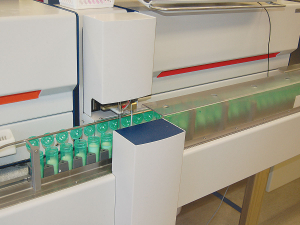MPI defends cost of new biosecurity lab
The head of the Ministry for Primary Industries (MPI) biosecurity operation, Stuart Anderson, has defended the cost and the need for a Plant Healht and Environment Laboratory (PHEL) being built in Auckland.
 The new test will allow a more accurate and timely decision on culling and calving pattern prediction for next season.
The new test will allow a more accurate and timely decision on culling and calving pattern prediction for next season.
A test to detect Johne's Disease and pregnancy from a single milk sample in cattle is being developed.
Auckland-based biotechnology company Pictor Limited says it has been developing a multiplex bovine test, via a $404,040 grant from the Ministry for Primary Industries (MPI) Sustainable Food and Fibre Futures Fund.
The test, which is being created in collaboration with Massey University, will initially aim to detect Johne's Disease and pregnancy from a single milk sample.
"Dairy cows are at risk of a range of bovine diseases including Johne's disease, which costs the industry up to $90 million annually in lost milk production and poor calving rates," Pictor chief operating officer Howard Moore says. "Affordability is a key barrier to farmer testing uptake."
Moore says while there is a range of individual tests on the market, routine testing is not yet the norm.
"The novel multiplex diagnostic technology will lower costs and bundle tests, thereby enabling more proactive and sustainable management of disease on-farm."
Moore adds that the loss of productivity in cows suffering from Johne's Disease is not the only cost.
"Current Johne's tests only have a moderate sensitivity," he claims. "Pictor's bovine test will incorporate multiple anitgens to achieve a fast, cost-effective and highly sensitive Johne's detection."
He says the new test will allow a more accurate and timely decision on culling and calving pattern prediction for next season.
The principle to improve sensitivity and better specificity stems from Pictor's M. bovis assay, supported through a research agreement with New Zealand's M. bovis programme fund.
"The more sensitive a test, the more reliable it is in picking up the disease," Moore explains.
This research project is led by Howard Moore, chief operating officer at Pictor, and Dr Rao Dukkipati, a senior lecturer at Massey University.
Long-term research at Massey, led by associate Professor Alan Murray, has identified several immunogenic proteins of Mycobacterium avium subsp. Paratuberculosis, the causative organism for Johne's.
Steve Penno, director investment programmes at MPI, says regular and early testing for Johne's and pregnancy, coupled with good management practices could increase herd productivity and boost calving rates.
"MPI is supporting this project because of its potential to boost productivity and environmental outcomes alongside healthier animals."
Pictor says it has filed the provisional patent for the diagnostic test.
Primary sector leaders have welcomed the announcement of a Free Trade Agreement between India and New Zealand.
|
A landmark moment for New Zealand. That's how Prime Minister Christopher Luxon describes the conclusion of negotiations for an India-New Zealand Free Trade Agreement. Beef Progeny Test 2025: Genetic insights for NZ beef industryAt Pāmu’s Kepler Farm in Manapouri, mating has wrapped up at the across-breed Beef Progeny Test. HortNZ celebrates 20 YearsMore than 150 people turned up at Parliament recently to celebrate the 20th anniversary of Horticulture New Zealand (HortNZ). Biosecurity NZ urges vigilance for yellow-legged hornetsBiosecurity New Zealand says Kiwis should continue to keep an eye out for yellow-legged hornets (Vespa velutina) over the holiday season. Mental Health and Fitness Unite: The Push-Up Challenge comes to New ZealandThe Push-Up Challenge, an event which combines mental health and fitness, is set to launch in New Zealand in 2026. NationalVelvetleaf: New Zealand’s most aggressive cropping weedVelvetleaf (Abutilon theophrasti) is an annual broad-leaved herb, originating in China, that can grow between 1 and 2.5 metres tall,…Farmers more satisfied with banks, but confidence remains below 2017 levelsAccording to the latest Federated Farmers banking survey, farmers are more satisfied with their bank and less under pressure, however,…Farmer confidence dips slightly, but positivity still dominatesFarmer confidence has taken a slight dip according to the final Rabobank rural confidence survey for the year.Nathan Guy is the new special agricultural trade envoyFormer Agriculture Minister and Otaki farmer Nathan Guy has been appointed New Zealand’s Special Agricultural Trade Envoy (SATE).Alliance commissions major heat pump system at Mataura, cutting coal use and emissionsAlliance Group has commissioned a new heat pump system at its Mataura processing plant in Southland.Machinery & ProductsAgriSpread AS3000 Bulk Spreader: Precision spreading up to 52mManufactured in Ireland, tested and launched at Agritechnica in Germany, AgriSpread’s new AS3000 bulk spreader takes much of the technology…Agritechnica 2025: Claas, Fendt and Valtra claim 2026 Tractor of the Year AwardsLast month's Agritechnica event led to a wide group of manufacturers celebrating successes when the 2026 Tractor of the Year…New Case IH Puma series debuts with improved design & precision techCase IH used Agritechnica to reveal its new Puma series tractor, featuring what it claims is an entirely new vehicle…New Holland unveils “Il Trattore” concept at AgritechnicaCreating a great deal of enthusiasm at Agritechnica, the T5.120 ‘Il Trattore’ styling concept tractor was celebrating the legacy of…Deutz-Fahr unveils all-new 8 series tractor range at AgritechnicaAgritechnica was the launchpad for several “new” tractors, most reworks of existing models, but Deutz Fahr ‘s new 8 Series was…» Latest Print Issues OnlineThe Hound
Yes, Minister!OPINION: The release of the Natural Environment Bill and Planning Bill to replace the Resource Management Act is a red-letter day… Two-legged pestsOPINION: Federated Farmers has launched a new campaign, swapping ‘The Twelve Days of Christmas’ for ‘The Twelve Pests of Christmas’ to… » Connect with Rural News» eNewsletter |